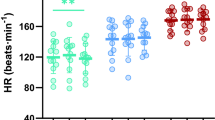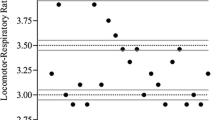Abstract
Purpose
This study compared cardiorespiratory and perceptual responses to exercise using self-regulated and imposed power outputs distributed between the arms and legs.
Methods
Ten males (age 21.7 ± 3.4 years) initially undertook incremental arm-crank ergometry (ACE) and cycle ergometry (CYC) tests to volitional exhaustion to determine peak power output (Wpeak). Two subsequent tests involved 20-min combined arm–leg ergometry (ALE) trials, using imposed and self-regulated protocols, both of which aimed to elicit an exercising heart rate of 160 beats min−1. During the imposed trial, arm and leg intensity were set at 40% of each ergometer-specific Wpeak. During the self-regulated trial, participants were asked to self-regulate cadence and resistance to achieve the target heart rate. Heart rate (HR), oxygen uptake (\(\dot {V}{{\text{O}}_{\text{2}}}\)), pulmonary ventilation (\({\dot {V}_{\text{E}}}\)), and ratings of perceived exertion (RPE) were recorded continuously.
Results
As expected, there were no differences between imposed and self-regulated trials for HR, \(\dot {V}{{\text{O}}_{\text{2}}}\), and \({\dot {V}_{\text{E}}}\) (all P ≥ 0.05). However, central RPE and local RPE for the arms were lower during self-regulated compared imposed trials (P ≤ 0.05). Lower RPE during the self-regulated trial was related to preferential adjustments in how the arms (33 ± 5% Wpeak) and legs (46 ± 5% Wpeak) contributed to the exercise intensity.
Conclusions
This study demonstrates that despite similar metabolic and cardiovascular strain elicited by imposed and self-regulated ALE, the latter was perceived to be less strenuous, which is related to participants doing more work with the legs and less work with the arms to achieve the target intensity.




Similar content being viewed by others
Abbreviations
- ALE:
-
Arm–leg ergometry
- ANOVA:
-
Analysis of variance
- ACE:
-
Arm-crank ergometry
- CYC:
-
Cycle ergometry
- d :
-
Cohen’s d effect sizes
- HR:
-
Heart rate
- RER:
-
Respiratory exchange ratio
- RPEC :
-
Central rating of perceived exertion
- RPEARMS :
-
Ratings of perceived exertion for arm musculature
- RPELEGS :
-
Ratings of perceived exertion for leg musculature
- \({\dot {V}_{\text{E}}}\) :
-
Pulmonary ventilation
- \(\dot {V}{{\text{O}}_{\text{2}}}\) :
-
Oxygen uptake
- \(\dot {V}{{\text{O}}_{{\text{2peak}}}}\) :
-
Peak oxygen uptake
- W peak :
-
Peak power output
References
Astrand PO, Saltin B (1961) Maximal oxygen uptake and heart rate in various types of muscular activity. J Appl Physiol 16(6):977–981
Bergh U, Kanstrup IL, Ekblom B (1976) Maximal oxygen uptake during exercise with various combinations of arm and leg work. J Appl Physiol 41(2):191–196
Borg GA (1982) Psychophysical bases of perceived exertion. Med Sci Sports Exerc 14(5):377–381
Buckley J, Eston R (2006) Ratings of perceived exertion. In: Winter ME, Jones AM, Davison RR, Bromley PD, Mercer T (eds) Sport and exercise physiology testing guidelines. Sport and exercise physiology testing guidelines: the British association of sport and exercise sciences guide, vol I: sport testing. Routledge, London
Eston RG, Brodie DA (1986) Responses to arm and leg ergometry. Br J Sports Med 20(1):4–6
Gleser MA, Horstman DH, Mello RP (1974) The effect on VO2 max of adding arm work to maximal leg work. Med Sci Sports Exerc 6(2):104–107
Gutin B, Ang KE, Torrey K (1988) Cardiorespiratory and subjective responses to incremental and constant load ergometry with arms and legs. Arch Phys Med Rehabil 69(7):510–513
Hagan RD, Gettman LR, Upton SJ, Duncan JJ, Cummings JM (1983) Cardiorespiratory responses to arm, leg, and combined arm and leg work on an air-braked ergometer. J Cardiac Rehabil 3:689–695
Hagerman FC, Connors MC, Gault JA, Hagerman GR, Polinski WJ (1978) Energy expenditure during simulated rowing. J Appl Physiol 45(1):87–93
Haile L, Gallagher M, Robertson RJ (2015) Self-selected versus imposed exercise intensities. In: Perceived exertion laboratory manual. Springer, New York, pp 163–177
Hill MW, Goss-Sampson M, Duncan MJ, Price MJ (2014) The effects of maximal and submaximal arm crank ergometry and cycle ergometry on postural sway. Eur J Sport Sci 14(8):782–790
Hoffman MD, Kassay KM, Zeni AI, Clifford PS (1996) Does the amount of exercising muscle alter the aerobic demand of dynamic exercise? Eur J Appl Physiol Occup Physiol 74(6):541–547
Kravitz L, Robergs RA, Heyward VH, Wagner DR, Powers K (1997) Exercise mode and gender comparisons of energy expenditure at self-selected intensities. Med Sci Sports Exerc 29(8):1028–1035
Mier CM, Feito Y (2006) Metabolic cost of stride rate, resistance, and combined use of arms and legs on the elliptical trainer. Res Q Exerc Sport 77(4):507–513
Nagle FJ, Richie JP, Giese MD (1984) VO2max responses in separate and combined arm and leg air-braked ergometer exercise. Med Sci Sports Exerc 16(6):563–566
Parfitt G, Rose EA, Burgess WM (2006) The psychological and physiological responses of sedentary individuals to prescribed and preferred intensity exercise. Br J Health Psychol 11:39–53
Reybrouck T, Heigenhauser GF, Faulkner JA (1975) Limitations to maximum oxygen uptake in arms, leg, and combined arm-leg ergometry. J Appl Physiol 38(5):774–779
Sakamoto M, Tazoe T, Nakajima T, Endoh T, Shiozawa S, Komiyama T (2007) Voluntary changes in leg cadence modulate arm cadence during simultaneous arm and leg cycling. Exp Brain Res 176(1):188–192
Sakamoto M, Tazoe T, Nakajima T, Endoh T, Komiyama T (2014) Leg automaticity is stronger than arm automaticity during simultaneous arm and leg cycling. Neurosci Let 564:62–66
Sawka MN (1986) Physiology of upper body exercise. Exerc Sport Sci Rev 14(1):175–212
Secher NH, Ruberg-Larsen N, Binkhorst RA, Bonde-Petersen F (1974) Maximal oxygen uptake during arm cranking and combined arm plus leg exercise. J Appl Physiol 36(5):515–518
Secher NH, Clausen JP, Klausen K, Noer I, Trap-Jensen J (1977) Central and regional circulatory effects of adding arm exercise to leg exercise. Acta Physiol 100(3):288–297
Stenberg J, Astrand P-O, Ekblom B, Royce J, Saltin B (1967) Hemodynamic responses to work with different muscle groups, sitting and supine. J Appl Physiol 22:61–70
Zeni AI, Hoffman MD, Clifford PS (1996) Energy expenditure with indoor exercise machines. Jama 275(18):1424–1427
Author information
Authors and Affiliations
Contributions
MH, MPr, and CT conceived and designed research. MH, CT, and MPu conducted experiments. MH wrote the manuscript. All authors read and approved the manuscript.
Corresponding author
Additional information
Communicated by Keith Phillip George.
Rights and permissions
About this article
Cite this article
Hill, M., Talbot, C., Puddiford, M. et al. Cardiorespiratory and perceptual responses to self-regulated and imposed submaximal arm–leg ergometry. Eur J Appl Physiol 118, 1011–1019 (2018). https://doi.org/10.1007/s00421-018-3838-7
Received:
Accepted:
Published:
Issue Date:
DOI: https://doi.org/10.1007/s00421-018-3838-7




